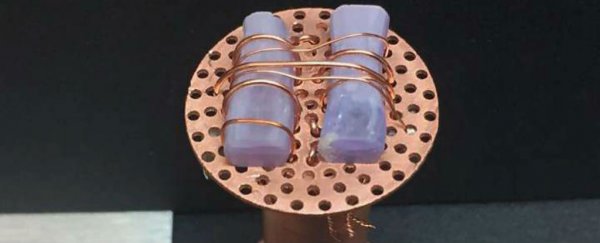Physicists have found evidence of quantum 'spookiness' going on inside a new type of exotic crystal, and say it could hint at an entire class of undiscovered materials that house a rarely encountered state of matter known as quantum spin liquid.
Quantum spin liquid materials have long been predicted by theoretical physicists, but we've only recently started to see evidence of them in nature. Now physicists have managed to make their own synthetic version, and it could have big implications for the quantum computers of the future.
The new quantum spin liquid material is a synthetically produced ytterbium crystal, made by physicists in China in 2015. A separate team from Georgia Institute of Technology has now found evidence that a quantum spin liquid state is hiding inside it.
If this is all sounding horribly complicated already, don't worry - physicists have been struggling to wrap their heads around quantum spin liquids for decades.
In quantum mechanics, "spin" doesn't refer to physical spinning, but instead describes a type of angular momentum that's intrinsic to a particle. It's basically used to describe how a particle behaves when it moves through a magnetic field, as if it had the properties of a tiny compass needle.
In a quantum spin liquid, the spins of electrons start interacting to create a highly disordered state, creating all kinds of strange behaviours.
As we reported back in April, in this state, the electrons don't align, but instead form an entangled 'soup' caused by quantum fluctuations.
This soup is made up of quantum entangled particles - particles that essentially 'share' an existence, which means that whatever happens to one particle will directly and instantly affect the other, even if that other particle is many light-years away.
So a quantum spin liquid is a system of billions of quantum entangled particles, all acting crazy. While their individual spins are going haywire, they're still behaving like a cohesive, connected group.
"Imagine a state of matter where this entanglement doesn't involve two electrons but involves, three, five, 10 or 10 billion particles all in the same system," Martin Mourigal from the Georgia Institute team explains.
"You can create a very, very exotic state of matter based on the fact that all these particles are entangled with each other. There are no individual particles anymore, but one huge electron ensemble acting collectively."
Like "spin", in this context, "liquid" doesn't refer to the everyday meaning of the word either, but instead describes the collective nature of electrons' spins.
"In a spin 'liquid', the directions of the spins are not tidily aligned, but frenzied, although the spins are interconnected, whereas in a spin 'solid' the spin directions have a neat organisation," Mourigal explains.
Back in 2006, researchers from MIT discovered that a naturally occurring crystal called herbertsmithite harboured quantum spin liquid. That emerald green stone, found in a Chilean mine back in 1972, is what this new synthetic ytterbium crystal was based on.
And now that there are hints of this bizarre state of matter in the ytterbium crystal too, Mourigal and his team suspect this is just the tip of the iceberg for quantum spin liquid materials.
"Finding herbertsmithite was like saying, 'Animals exist.' But there are so many different species of animals, or mammals, or fish, reptiles, and birds," he said. "Now that we have found one, we are looking for different kinds of spin liquids."
Mourigal and his team discovered the elusive state by using a powerful superconducting magnet to line the spins of electrons up in an orderly fashion inside their ytterbium crystal (pictured at the top of the page).
"Then we removed the magnetic field, and let them go back to their special kind of wiggling," Mourigal said.
Instead of the entangled particles flipping their spin in unison, as they would in a regular quantum state, they all just did their own thing within the group.
"This jumbly kind of spin wave broke down into many other waves, because everything is collective, everything is entangled," Mourigal explains. "It was a continuum of excitations, but breaking down across many electrons at once."
The team's observations mirrored what was observed inside the naturally occurring herbertsmithite crystal, but in order to confirm that their ytterbium crystal truly is a quantum spin liquid material, it's going to have to undergo a years-long string of independent mathematical tests.
But Mourigal isn't too concerned about the pressure this will put on his team's results: "At first glance, this material is screaming, 'I'm a quantum spin liquid.'"
Hopefully, it's telling the truth.
The results have been published in Nature Physics.
